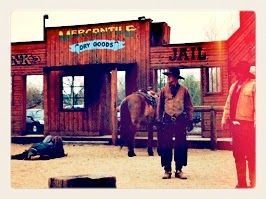With GoDaddy pulling its "Puppy Mill" ad, all eyes are now on Charlotte McKinney for Carl's Jr. to steal the top spot for most controversial Super Bowl advertisement this year. The advertisement, which will only run on the West Coast, features the top model bounding through a farmer's market.
What makes the advertisement "controversial" is that McKinney appears to be naked in the majority of the spot, thanks to camera framing and prop placement. Feeding the fantasy is a series of gawking men who alternate between being distracted by the blonde beauty and fondling produce in front of her.
The commercial is supposed to sell a new hamburger for the quick service franchise, but mostly it sells McKinney. She usurps Paris Hilton and other socialites that Carl's Jr. has employed to sell food with sex. This time the caustic relationship is being all natural, alluding to nakedness and not altered.
Overall, the commercial does a great job at selling McKinney, but not such a great job at selling product. Most people struggle to remember the name of the new burger, a problem that isn't new for the fast food chain on the bottom of the big five burger businesses.
The problem isn't new. Most people don't remember what kind of burger Hilton or Heidi Klum ate either (and some can't remember the chain that supplied the sloppy eats). And even after doubling down on their decision to make premier hamburgers part of the product offering for Carl's Jr. and Hardees, the CKE business model has yet to eek out one percent of the quick burger market share.
To put that into perspective, its primary competition — Burger King, Wendy's, and Jack In The Box — have all captured 2 percent of the market. Meanwhile, McDonald's isn't even in the same category, owning 19 percent of the market share. The only reason it feels like the two compete for customers is that Carl's Jr. requires stores to spend about 5.8 percent of their sales on advertising to supplement regional advertising buys. In other words, the CKE sister chains tend to be more talk and less eat.
The Charlotte McKinney ad is less controversial and more boring.
Let's be clear. McKinney is not boring. She does a fabulous job with a bad script and mediocre concept. Her presence in the spot is largely the freshest thing about it. The chain traded up in terms of spokespeople. It's a shame they didn't trade up their creative too.
The advertisement is a rehash of Benny Hill comedy with an Austin Powers twist. It pretends to be controversial, mostly because Carl's Jr. claims it is too hot for television, a boast that perpetuates some outdated masculine myth that women used to be sexually stymied but are now liberated, which is good news for men who love to objectify them.
 Aside from that, it also perpetuates the myths that sex sells and attention is the end all of advertising. On the contrary, sex doesn't sell and publicity is cheap. Naked women aren't clever. They are a punt when every other play had failed and nobody in the room can come up with anything remotely clever.
Aside from that, it also perpetuates the myths that sex sells and attention is the end all of advertising. On the contrary, sex doesn't sell and publicity is cheap. Naked women aren't clever. They are a punt when every other play had failed and nobody in the room can come up with anything remotely clever.
This lack of creativity might even be contagious. Sex in advertising has been on a steady rise since the 1980s despite studies that show as many as 60 percent of consumers have a negative reaction to such advertising and women, specifically, are bored and disinterested in sex-infused advertising.
So where is the disconnect? Most people attribute it to the outmoded thinking of male executives who make the decisions and sophomoric creative types who lament that their best years were in college. I see it a bit differently, but only because I know hack creatives take most of their cues from television.
As television has become more titillating, they think advertising should follow suit. The only problem is that they never consider the context. Just because people tune into a sexually explicit show doesn't mean they want their advertisements to feature leering men and objectified women. The setup is done to death.
The push back that anyone who doesn't like it is a prude is banal.
All this isn't to say that sex ought to be excluded from advertising. There are plenty of treatments where it can work provided the creative doesn't eclipse the product. Consumers have a much more positive reason to like sex in advertisements when it's wholesome, sexily sensual, or smartly funny.
Those types of treatments tend to skip the stereotypes as they were defined in the 1980s. Nowadays, sexual liberation isn't defined by someone's tolerance for soft porn, but rather their maturity to see it as clean, consensual, and occasionally clever in its use of innuendo and humor. And unlike movies and television, copywriters and creative directors ought to remember that they have two jobs that fiction writers do not.
Modern advertising not only sells the product, but often holds up a mirror to its audience. So if the audience can't relate to the spot, don't expect them to respond to the product. They're much more likely to critique your ad instead, which is exactly what most people who have seen this ad have done. Hat tip to Geoff Livingston for the topic.
What makes the advertisement "controversial" is that McKinney appears to be naked in the majority of the spot, thanks to camera framing and prop placement. Feeding the fantasy is a series of gawking men who alternate between being distracted by the blonde beauty and fondling produce in front of her.
The commercial is supposed to sell a new hamburger for the quick service franchise, but mostly it sells McKinney. She usurps Paris Hilton and other socialites that Carl's Jr. has employed to sell food with sex. This time the caustic relationship is being all natural, alluding to nakedness and not altered.
Overall, the commercial does a great job at selling McKinney, but not such a great job at selling product. Most people struggle to remember the name of the new burger, a problem that isn't new for the fast food chain on the bottom of the big five burger businesses.
The problem isn't new. Most people don't remember what kind of burger Hilton or Heidi Klum ate either (and some can't remember the chain that supplied the sloppy eats). And even after doubling down on their decision to make premier hamburgers part of the product offering for Carl's Jr. and Hardees, the CKE business model has yet to eek out one percent of the quick burger market share.
To put that into perspective, its primary competition — Burger King, Wendy's, and Jack In The Box — have all captured 2 percent of the market. Meanwhile, McDonald's isn't even in the same category, owning 19 percent of the market share. The only reason it feels like the two compete for customers is that Carl's Jr. requires stores to spend about 5.8 percent of their sales on advertising to supplement regional advertising buys. In other words, the CKE sister chains tend to be more talk and less eat.
The Charlotte McKinney ad is less controversial and more boring.
Let's be clear. McKinney is not boring. She does a fabulous job with a bad script and mediocre concept. Her presence in the spot is largely the freshest thing about it. The chain traded up in terms of spokespeople. It's a shame they didn't trade up their creative too.
The advertisement is a rehash of Benny Hill comedy with an Austin Powers twist. It pretends to be controversial, mostly because Carl's Jr. claims it is too hot for television, a boast that perpetuates some outdated masculine myth that women used to be sexually stymied but are now liberated, which is good news for men who love to objectify them.
 Aside from that, it also perpetuates the myths that sex sells and attention is the end all of advertising. On the contrary, sex doesn't sell and publicity is cheap. Naked women aren't clever. They are a punt when every other play had failed and nobody in the room can come up with anything remotely clever.
Aside from that, it also perpetuates the myths that sex sells and attention is the end all of advertising. On the contrary, sex doesn't sell and publicity is cheap. Naked women aren't clever. They are a punt when every other play had failed and nobody in the room can come up with anything remotely clever.This lack of creativity might even be contagious. Sex in advertising has been on a steady rise since the 1980s despite studies that show as many as 60 percent of consumers have a negative reaction to such advertising and women, specifically, are bored and disinterested in sex-infused advertising.
So where is the disconnect? Most people attribute it to the outmoded thinking of male executives who make the decisions and sophomoric creative types who lament that their best years were in college. I see it a bit differently, but only because I know hack creatives take most of their cues from television.
As television has become more titillating, they think advertising should follow suit. The only problem is that they never consider the context. Just because people tune into a sexually explicit show doesn't mean they want their advertisements to feature leering men and objectified women. The setup is done to death.
The push back that anyone who doesn't like it is a prude is banal.
All this isn't to say that sex ought to be excluded from advertising. There are plenty of treatments where it can work provided the creative doesn't eclipse the product. Consumers have a much more positive reason to like sex in advertisements when it's wholesome, sexily sensual, or smartly funny.
Those types of treatments tend to skip the stereotypes as they were defined in the 1980s. Nowadays, sexual liberation isn't defined by someone's tolerance for soft porn, but rather their maturity to see it as clean, consensual, and occasionally clever in its use of innuendo and humor. And unlike movies and television, copywriters and creative directors ought to remember that they have two jobs that fiction writers do not.
Modern advertising not only sells the product, but often holds up a mirror to its audience. So if the audience can't relate to the spot, don't expect them to respond to the product. They're much more likely to critique your ad instead, which is exactly what most people who have seen this ad have done. Hat tip to Geoff Livingston for the topic.













































